MGSM869 Social Entrepreneurship Final Assignment: Term 1, 2018
VerifiedAdded on 2021/04/20
|10
|4051
|39
Homework Assignment
AI Summary
This assignment explores the multifaceted concept of social entrepreneurship, focusing on its role in addressing societal issues, particularly poverty. It begins by defining entrepreneurship and social entrepreneurship, highlighting the significance of eradicating poverty as a global goal. The assignment then delves into the characteristics of social entrepreneurs, emphasizing motivation, purpose, innovation, and business acumen. It contrasts social enterprises with traditional charities and businesses, underscoring their aim to achieve measurable social impact alongside financial returns. The document discusses various stages of social entrepreneurship, including legitimacy, needs recognition, group coalescence, and organizational establishment, detailing the required qualities at each stage. It uses examples like Bill Drayton and Ashoka to illustrate successful social entrepreneurship. The assignment also examines the impact of social enterprises, the role of the internet and social media, and the importance of income generation and employment enhancement programs in eradicating poverty. The document emphasizes the need for calculated risk-taking, communication skills, and strong networking abilities in the field. Overall, the assignment provides a comprehensive overview of social entrepreneurship, its impact on society, and the key elements for success in this domain.
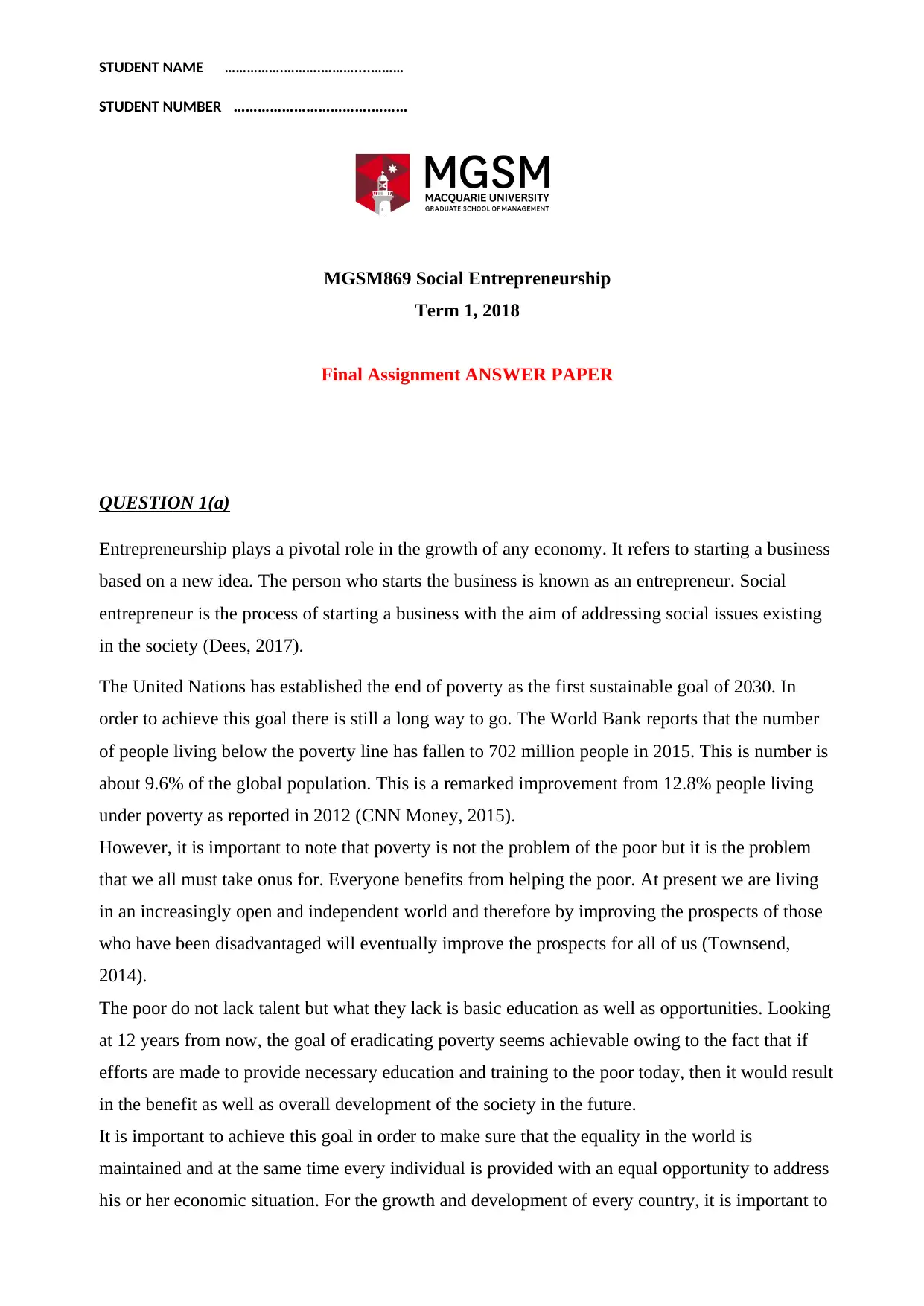
STUDENT NAME …………….……….………....………
STUDENT NUMBER …………………………….………
MGSM869 Social Entrepreneurship
Term 1, 2018
Final Assignment ANSWER PAPER
QUESTION 1(a)
Entrepreneurship plays a pivotal role in the growth of any economy. It refers to starting a business
based on a new idea. The person who starts the business is known as an entrepreneur. Social
entrepreneur is the process of starting a business with the aim of addressing social issues existing
in the society (Dees, 2017).
The United Nations has established the end of poverty as the first sustainable goal of 2030. In
order to achieve this goal there is still a long way to go. The World Bank reports that the number
of people living below the poverty line has fallen to 702 million people in 2015. This is number is
about 9.6% of the global population. This is a remarked improvement from 12.8% people living
under poverty as reported in 2012 (CNN Money, 2015).
However, it is important to note that poverty is not the problem of the poor but it is the problem
that we all must take onus for. Everyone benefits from helping the poor. At present we are living
in an increasingly open and independent world and therefore by improving the prospects of those
who have been disadvantaged will eventually improve the prospects for all of us (Townsend,
2014).
The poor do not lack talent but what they lack is basic education as well as opportunities. Looking
at 12 years from now, the goal of eradicating poverty seems achievable owing to the fact that if
efforts are made to provide necessary education and training to the poor today, then it would result
in the benefit as well as overall development of the society in the future.
It is important to achieve this goal in order to make sure that the equality in the world is
maintained and at the same time every individual is provided with an equal opportunity to address
his or her economic situation. For the growth and development of every country, it is important to
STUDENT NUMBER …………………………….………
MGSM869 Social Entrepreneurship
Term 1, 2018
Final Assignment ANSWER PAPER
QUESTION 1(a)
Entrepreneurship plays a pivotal role in the growth of any economy. It refers to starting a business
based on a new idea. The person who starts the business is known as an entrepreneur. Social
entrepreneur is the process of starting a business with the aim of addressing social issues existing
in the society (Dees, 2017).
The United Nations has established the end of poverty as the first sustainable goal of 2030. In
order to achieve this goal there is still a long way to go. The World Bank reports that the number
of people living below the poverty line has fallen to 702 million people in 2015. This is number is
about 9.6% of the global population. This is a remarked improvement from 12.8% people living
under poverty as reported in 2012 (CNN Money, 2015).
However, it is important to note that poverty is not the problem of the poor but it is the problem
that we all must take onus for. Everyone benefits from helping the poor. At present we are living
in an increasingly open and independent world and therefore by improving the prospects of those
who have been disadvantaged will eventually improve the prospects for all of us (Townsend,
2014).
The poor do not lack talent but what they lack is basic education as well as opportunities. Looking
at 12 years from now, the goal of eradicating poverty seems achievable owing to the fact that if
efforts are made to provide necessary education and training to the poor today, then it would result
in the benefit as well as overall development of the society in the future.
It is important to achieve this goal in order to make sure that the equality in the world is
maintained and at the same time every individual is provided with an equal opportunity to address
his or her economic situation. For the growth and development of every country, it is important to
Paraphrase This Document
Need a fresh take? Get an instant paraphrase of this document with our AI Paraphraser
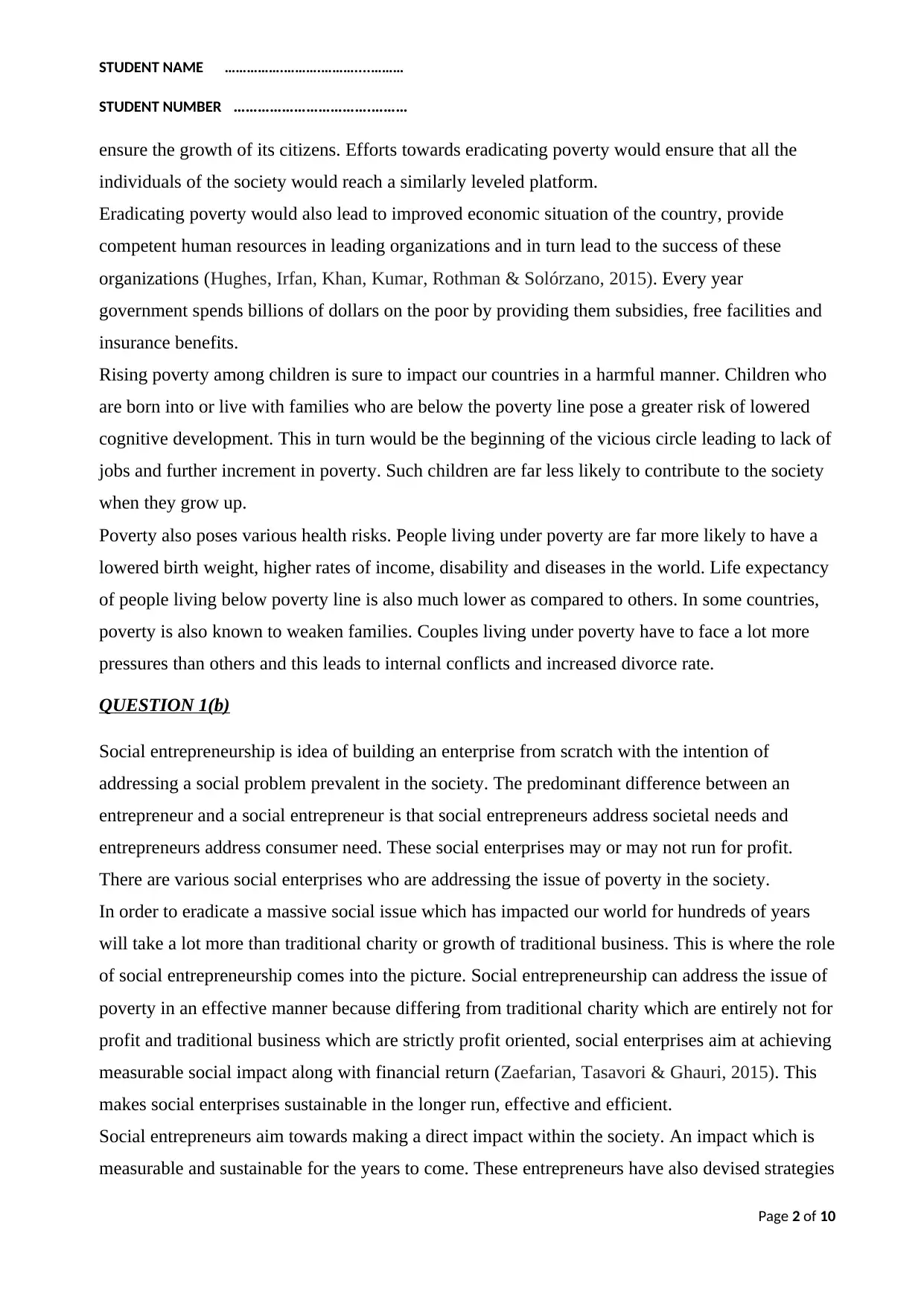
STUDENT NAME …………….……….………....………
STUDENT NUMBER …………………………….………
ensure the growth of its citizens. Efforts towards eradicating poverty would ensure that all the
individuals of the society would reach a similarly leveled platform.
Eradicating poverty would also lead to improved economic situation of the country, provide
competent human resources in leading organizations and in turn lead to the success of these
organizations (Hughes, Irfan, Khan, Kumar, Rothman & Solórzano, 2015). Every year
government spends billions of dollars on the poor by providing them subsidies, free facilities and
insurance benefits.
Rising poverty among children is sure to impact our countries in a harmful manner. Children who
are born into or live with families who are below the poverty line pose a greater risk of lowered
cognitive development. This in turn would be the beginning of the vicious circle leading to lack of
jobs and further increment in poverty. Such children are far less likely to contribute to the society
when they grow up.
Poverty also poses various health risks. People living under poverty are far more likely to have a
lowered birth weight, higher rates of income, disability and diseases in the world. Life expectancy
of people living below poverty line is also much lower as compared to others. In some countries,
poverty is also known to weaken families. Couples living under poverty have to face a lot more
pressures than others and this leads to internal conflicts and increased divorce rate.
QUESTION 1(b)
Social entrepreneurship is idea of building an enterprise from scratch with the intention of
addressing a social problem prevalent in the society. The predominant difference between an
entrepreneur and a social entrepreneur is that social entrepreneurs address societal needs and
entrepreneurs address consumer need. These social enterprises may or may not run for profit.
There are various social enterprises who are addressing the issue of poverty in the society.
In order to eradicate a massive social issue which has impacted our world for hundreds of years
will take a lot more than traditional charity or growth of traditional business. This is where the role
of social entrepreneurship comes into the picture. Social entrepreneurship can address the issue of
poverty in an effective manner because differing from traditional charity which are entirely not for
profit and traditional business which are strictly profit oriented, social enterprises aim at achieving
measurable social impact along with financial return (Zaefarian, Tasavori & Ghauri, 2015). This
makes social enterprises sustainable in the longer run, effective and efficient.
Social entrepreneurs aim towards making a direct impact within the society. An impact which is
measurable and sustainable for the years to come. These entrepreneurs have also devised strategies
Page 2 of 10
STUDENT NUMBER …………………………….………
ensure the growth of its citizens. Efforts towards eradicating poverty would ensure that all the
individuals of the society would reach a similarly leveled platform.
Eradicating poverty would also lead to improved economic situation of the country, provide
competent human resources in leading organizations and in turn lead to the success of these
organizations (Hughes, Irfan, Khan, Kumar, Rothman & Solórzano, 2015). Every year
government spends billions of dollars on the poor by providing them subsidies, free facilities and
insurance benefits.
Rising poverty among children is sure to impact our countries in a harmful manner. Children who
are born into or live with families who are below the poverty line pose a greater risk of lowered
cognitive development. This in turn would be the beginning of the vicious circle leading to lack of
jobs and further increment in poverty. Such children are far less likely to contribute to the society
when they grow up.
Poverty also poses various health risks. People living under poverty are far more likely to have a
lowered birth weight, higher rates of income, disability and diseases in the world. Life expectancy
of people living below poverty line is also much lower as compared to others. In some countries,
poverty is also known to weaken families. Couples living under poverty have to face a lot more
pressures than others and this leads to internal conflicts and increased divorce rate.
QUESTION 1(b)
Social entrepreneurship is idea of building an enterprise from scratch with the intention of
addressing a social problem prevalent in the society. The predominant difference between an
entrepreneur and a social entrepreneur is that social entrepreneurs address societal needs and
entrepreneurs address consumer need. These social enterprises may or may not run for profit.
There are various social enterprises who are addressing the issue of poverty in the society.
In order to eradicate a massive social issue which has impacted our world for hundreds of years
will take a lot more than traditional charity or growth of traditional business. This is where the role
of social entrepreneurship comes into the picture. Social entrepreneurship can address the issue of
poverty in an effective manner because differing from traditional charity which are entirely not for
profit and traditional business which are strictly profit oriented, social enterprises aim at achieving
measurable social impact along with financial return (Zaefarian, Tasavori & Ghauri, 2015). This
makes social enterprises sustainable in the longer run, effective and efficient.
Social entrepreneurs aim towards making a direct impact within the society. An impact which is
measurable and sustainable for the years to come. These entrepreneurs have also devised strategies
Page 2 of 10
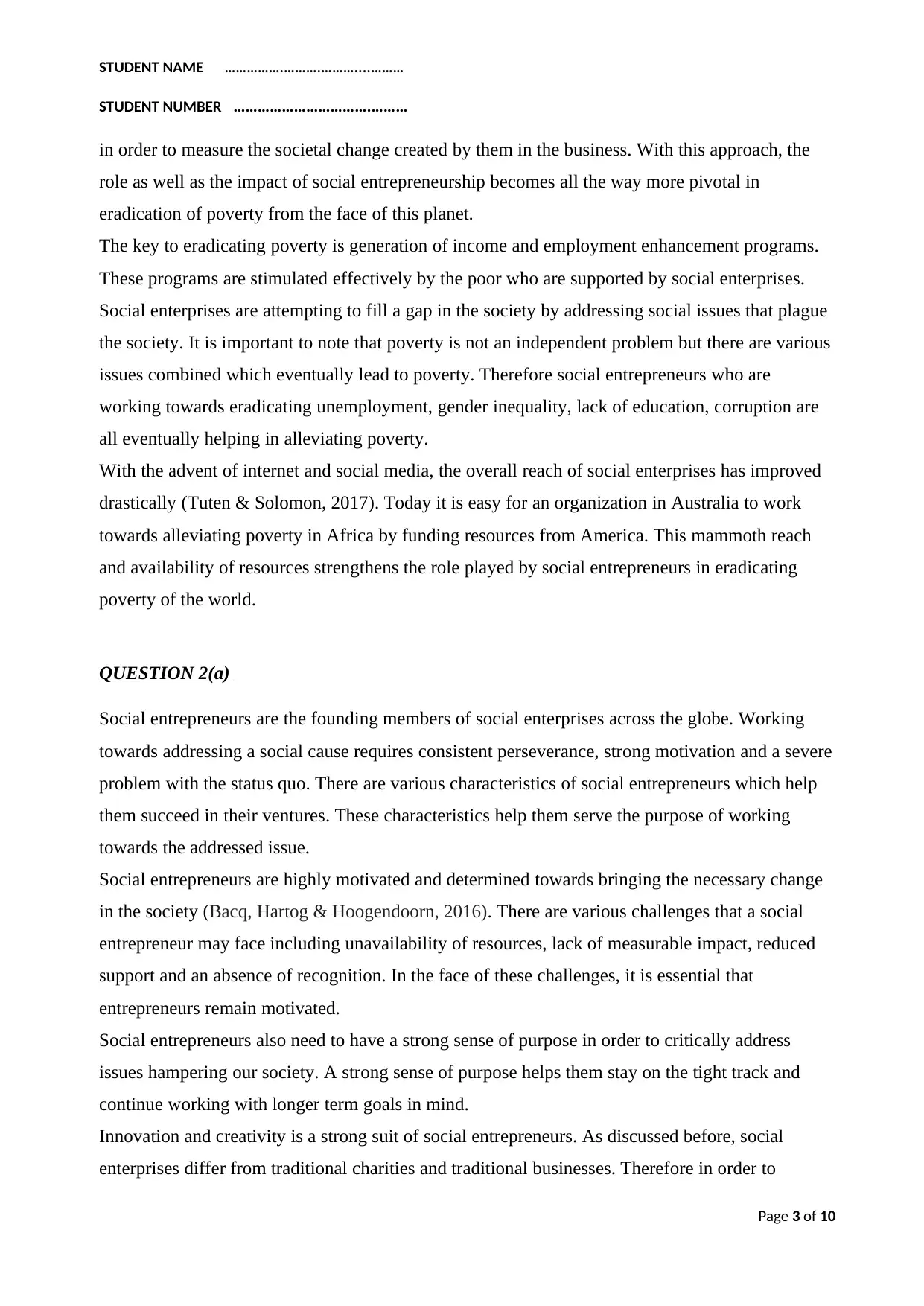
STUDENT NAME …………….……….………....………
STUDENT NUMBER …………………………….………
in order to measure the societal change created by them in the business. With this approach, the
role as well as the impact of social entrepreneurship becomes all the way more pivotal in
eradication of poverty from the face of this planet.
The key to eradicating poverty is generation of income and employment enhancement programs.
These programs are stimulated effectively by the poor who are supported by social enterprises.
Social enterprises are attempting to fill a gap in the society by addressing social issues that plague
the society. It is important to note that poverty is not an independent problem but there are various
issues combined which eventually lead to poverty. Therefore social entrepreneurs who are
working towards eradicating unemployment, gender inequality, lack of education, corruption are
all eventually helping in alleviating poverty.
With the advent of internet and social media, the overall reach of social enterprises has improved
drastically (Tuten & Solomon, 2017). Today it is easy for an organization in Australia to work
towards alleviating poverty in Africa by funding resources from America. This mammoth reach
and availability of resources strengthens the role played by social entrepreneurs in eradicating
poverty of the world.
QUESTION 2(a)
Social entrepreneurs are the founding members of social enterprises across the globe. Working
towards addressing a social cause requires consistent perseverance, strong motivation and a severe
problem with the status quo. There are various characteristics of social entrepreneurs which help
them succeed in their ventures. These characteristics help them serve the purpose of working
towards the addressed issue.
Social entrepreneurs are highly motivated and determined towards bringing the necessary change
in the society (Bacq, Hartog & Hoogendoorn, 2016). There are various challenges that a social
entrepreneur may face including unavailability of resources, lack of measurable impact, reduced
support and an absence of recognition. In the face of these challenges, it is essential that
entrepreneurs remain motivated.
Social entrepreneurs also need to have a strong sense of purpose in order to critically address
issues hampering our society. A strong sense of purpose helps them stay on the tight track and
continue working with longer term goals in mind.
Innovation and creativity is a strong suit of social entrepreneurs. As discussed before, social
enterprises differ from traditional charities and traditional businesses. Therefore in order to
Page 3 of 10
STUDENT NUMBER …………………………….………
in order to measure the societal change created by them in the business. With this approach, the
role as well as the impact of social entrepreneurship becomes all the way more pivotal in
eradication of poverty from the face of this planet.
The key to eradicating poverty is generation of income and employment enhancement programs.
These programs are stimulated effectively by the poor who are supported by social enterprises.
Social enterprises are attempting to fill a gap in the society by addressing social issues that plague
the society. It is important to note that poverty is not an independent problem but there are various
issues combined which eventually lead to poverty. Therefore social entrepreneurs who are
working towards eradicating unemployment, gender inequality, lack of education, corruption are
all eventually helping in alleviating poverty.
With the advent of internet and social media, the overall reach of social enterprises has improved
drastically (Tuten & Solomon, 2017). Today it is easy for an organization in Australia to work
towards alleviating poverty in Africa by funding resources from America. This mammoth reach
and availability of resources strengthens the role played by social entrepreneurs in eradicating
poverty of the world.
QUESTION 2(a)
Social entrepreneurs are the founding members of social enterprises across the globe. Working
towards addressing a social cause requires consistent perseverance, strong motivation and a severe
problem with the status quo. There are various characteristics of social entrepreneurs which help
them succeed in their ventures. These characteristics help them serve the purpose of working
towards the addressed issue.
Social entrepreneurs are highly motivated and determined towards bringing the necessary change
in the society (Bacq, Hartog & Hoogendoorn, 2016). There are various challenges that a social
entrepreneur may face including unavailability of resources, lack of measurable impact, reduced
support and an absence of recognition. In the face of these challenges, it is essential that
entrepreneurs remain motivated.
Social entrepreneurs also need to have a strong sense of purpose in order to critically address
issues hampering our society. A strong sense of purpose helps them stay on the tight track and
continue working with longer term goals in mind.
Innovation and creativity is a strong suit of social entrepreneurs. As discussed before, social
enterprises differ from traditional charities and traditional businesses. Therefore in order to
Page 3 of 10
⊘ This is a preview!⊘
Do you want full access?
Subscribe today to unlock all pages.

Trusted by 1+ million students worldwide
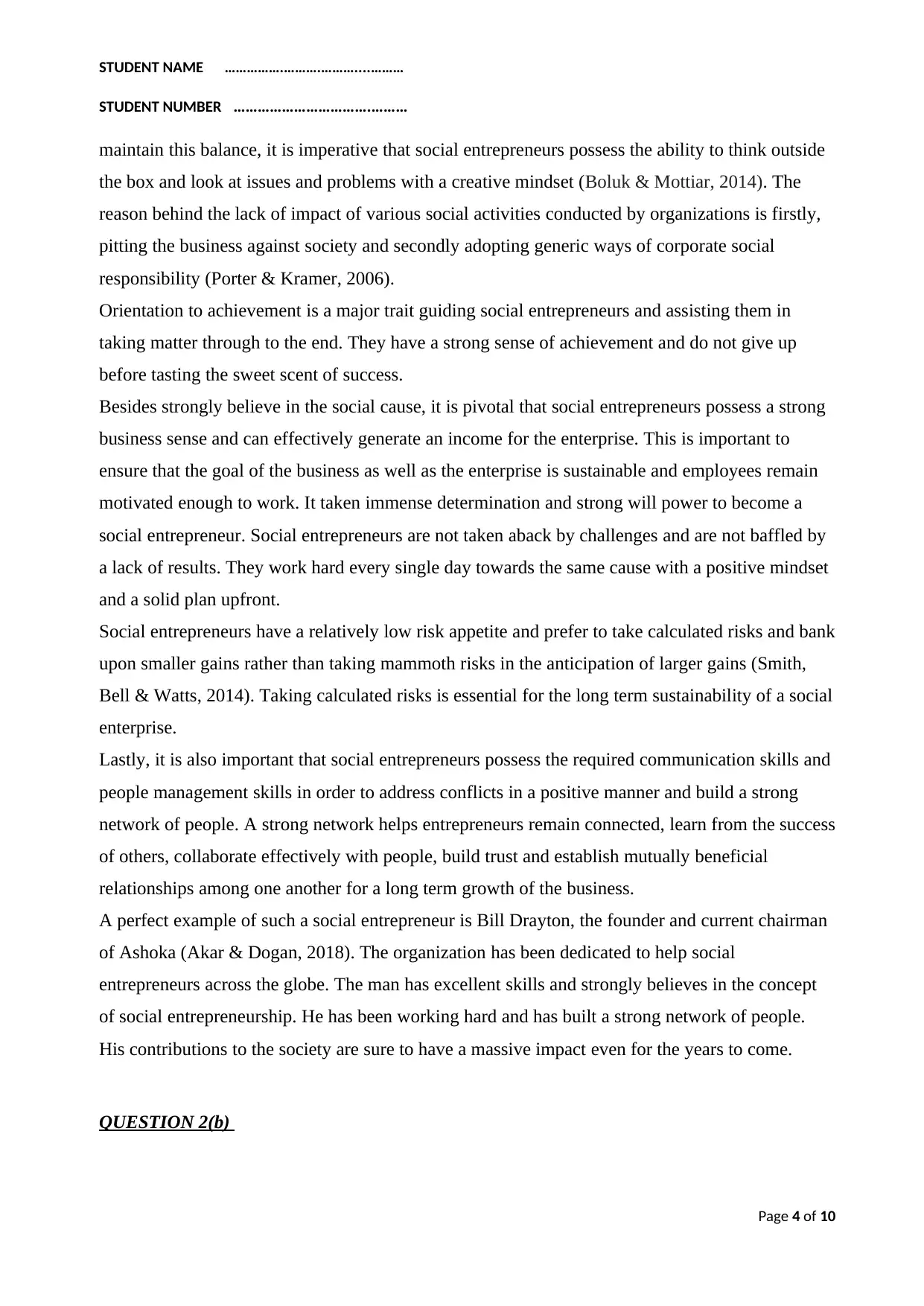
STUDENT NAME …………….……….………....………
STUDENT NUMBER …………………………….………
maintain this balance, it is imperative that social entrepreneurs possess the ability to think outside
the box and look at issues and problems with a creative mindset (Boluk & Mottiar, 2014). The
reason behind the lack of impact of various social activities conducted by organizations is firstly,
pitting the business against society and secondly adopting generic ways of corporate social
responsibility (Porter & Kramer, 2006).
Orientation to achievement is a major trait guiding social entrepreneurs and assisting them in
taking matter through to the end. They have a strong sense of achievement and do not give up
before tasting the sweet scent of success.
Besides strongly believe in the social cause, it is pivotal that social entrepreneurs possess a strong
business sense and can effectively generate an income for the enterprise. This is important to
ensure that the goal of the business as well as the enterprise is sustainable and employees remain
motivated enough to work. It taken immense determination and strong will power to become a
social entrepreneur. Social entrepreneurs are not taken aback by challenges and are not baffled by
a lack of results. They work hard every single day towards the same cause with a positive mindset
and a solid plan upfront.
Social entrepreneurs have a relatively low risk appetite and prefer to take calculated risks and bank
upon smaller gains rather than taking mammoth risks in the anticipation of larger gains (Smith,
Bell & Watts, 2014). Taking calculated risks is essential for the long term sustainability of a social
enterprise.
Lastly, it is also important that social entrepreneurs possess the required communication skills and
people management skills in order to address conflicts in a positive manner and build a strong
network of people. A strong network helps entrepreneurs remain connected, learn from the success
of others, collaborate effectively with people, build trust and establish mutually beneficial
relationships among one another for a long term growth of the business.
A perfect example of such a social entrepreneur is Bill Drayton, the founder and current chairman
of Ashoka (Akar & Dogan, 2018). The organization has been dedicated to help social
entrepreneurs across the globe. The man has excellent skills and strongly believes in the concept
of social entrepreneurship. He has been working hard and has built a strong network of people.
His contributions to the society are sure to have a massive impact even for the years to come.
QUESTION 2(b)
Page 4 of 10
STUDENT NUMBER …………………………….………
maintain this balance, it is imperative that social entrepreneurs possess the ability to think outside
the box and look at issues and problems with a creative mindset (Boluk & Mottiar, 2014). The
reason behind the lack of impact of various social activities conducted by organizations is firstly,
pitting the business against society and secondly adopting generic ways of corporate social
responsibility (Porter & Kramer, 2006).
Orientation to achievement is a major trait guiding social entrepreneurs and assisting them in
taking matter through to the end. They have a strong sense of achievement and do not give up
before tasting the sweet scent of success.
Besides strongly believe in the social cause, it is pivotal that social entrepreneurs possess a strong
business sense and can effectively generate an income for the enterprise. This is important to
ensure that the goal of the business as well as the enterprise is sustainable and employees remain
motivated enough to work. It taken immense determination and strong will power to become a
social entrepreneur. Social entrepreneurs are not taken aback by challenges and are not baffled by
a lack of results. They work hard every single day towards the same cause with a positive mindset
and a solid plan upfront.
Social entrepreneurs have a relatively low risk appetite and prefer to take calculated risks and bank
upon smaller gains rather than taking mammoth risks in the anticipation of larger gains (Smith,
Bell & Watts, 2014). Taking calculated risks is essential for the long term sustainability of a social
enterprise.
Lastly, it is also important that social entrepreneurs possess the required communication skills and
people management skills in order to address conflicts in a positive manner and build a strong
network of people. A strong network helps entrepreneurs remain connected, learn from the success
of others, collaborate effectively with people, build trust and establish mutually beneficial
relationships among one another for a long term growth of the business.
A perfect example of such a social entrepreneur is Bill Drayton, the founder and current chairman
of Ashoka (Akar & Dogan, 2018). The organization has been dedicated to help social
entrepreneurs across the globe. The man has excellent skills and strongly believes in the concept
of social entrepreneurship. He has been working hard and has built a strong network of people.
His contributions to the society are sure to have a massive impact even for the years to come.
QUESTION 2(b)
Page 4 of 10
Paraphrase This Document
Need a fresh take? Get an instant paraphrase of this document with our AI Paraphraser
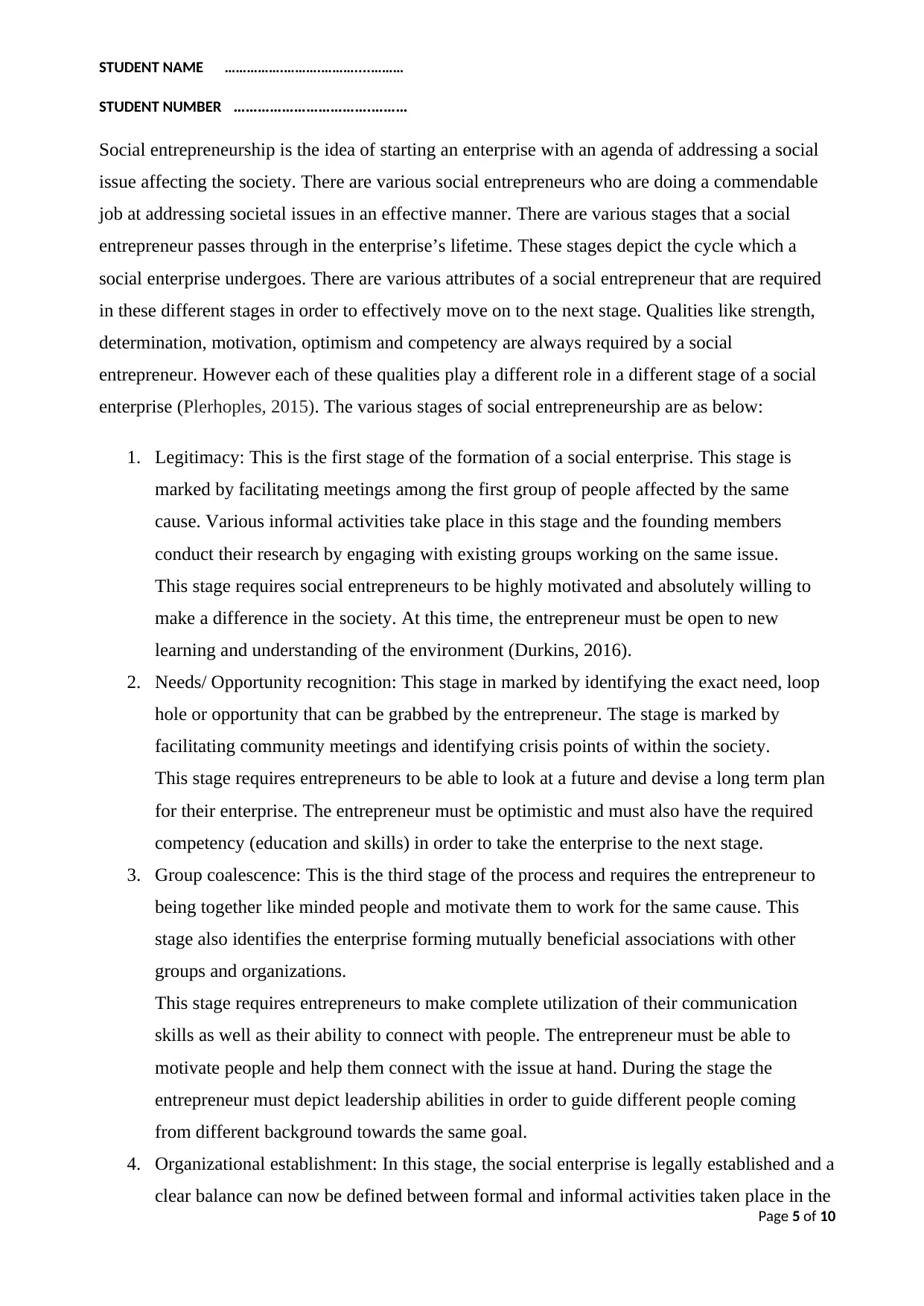
STUDENT NAME …………….……….………....………
STUDENT NUMBER …………………………….………
Social entrepreneurship is the idea of starting an enterprise with an agenda of addressing a social
issue affecting the society. There are various social entrepreneurs who are doing a commendable
job at addressing societal issues in an effective manner. There are various stages that a social
entrepreneur passes through in the enterprise’s lifetime. These stages depict the cycle which a
social enterprise undergoes. There are various attributes of a social entrepreneur that are required
in these different stages in order to effectively move on to the next stage. Qualities like strength,
determination, motivation, optimism and competency are always required by a social
entrepreneur. However each of these qualities play a different role in a different stage of a social
enterprise (Plerhoples, 2015). The various stages of social entrepreneurship are as below:
1. Legitimacy: This is the first stage of the formation of a social enterprise. This stage is
marked by facilitating meetings among the first group of people affected by the same
cause. Various informal activities take place in this stage and the founding members
conduct their research by engaging with existing groups working on the same issue.
This stage requires social entrepreneurs to be highly motivated and absolutely willing to
make a difference in the society. At this time, the entrepreneur must be open to new
learning and understanding of the environment (Durkins, 2016).
2. Needs/ Opportunity recognition: This stage in marked by identifying the exact need, loop
hole or opportunity that can be grabbed by the entrepreneur. The stage is marked by
facilitating community meetings and identifying crisis points of within the society.
This stage requires entrepreneurs to be able to look at a future and devise a long term plan
for their enterprise. The entrepreneur must be optimistic and must also have the required
competency (education and skills) in order to take the enterprise to the next stage.
3. Group coalescence: This is the third stage of the process and requires the entrepreneur to
being together like minded people and motivate them to work for the same cause. This
stage also identifies the enterprise forming mutually beneficial associations with other
groups and organizations.
This stage requires entrepreneurs to make complete utilization of their communication
skills as well as their ability to connect with people. The entrepreneur must be able to
motivate people and help them connect with the issue at hand. During the stage the
entrepreneur must depict leadership abilities in order to guide different people coming
from different background towards the same goal.
4. Organizational establishment: In this stage, the social enterprise is legally established and a
clear balance can now be defined between formal and informal activities taken place in the
Page 5 of 10
STUDENT NUMBER …………………………….………
Social entrepreneurship is the idea of starting an enterprise with an agenda of addressing a social
issue affecting the society. There are various social entrepreneurs who are doing a commendable
job at addressing societal issues in an effective manner. There are various stages that a social
entrepreneur passes through in the enterprise’s lifetime. These stages depict the cycle which a
social enterprise undergoes. There are various attributes of a social entrepreneur that are required
in these different stages in order to effectively move on to the next stage. Qualities like strength,
determination, motivation, optimism and competency are always required by a social
entrepreneur. However each of these qualities play a different role in a different stage of a social
enterprise (Plerhoples, 2015). The various stages of social entrepreneurship are as below:
1. Legitimacy: This is the first stage of the formation of a social enterprise. This stage is
marked by facilitating meetings among the first group of people affected by the same
cause. Various informal activities take place in this stage and the founding members
conduct their research by engaging with existing groups working on the same issue.
This stage requires social entrepreneurs to be highly motivated and absolutely willing to
make a difference in the society. At this time, the entrepreneur must be open to new
learning and understanding of the environment (Durkins, 2016).
2. Needs/ Opportunity recognition: This stage in marked by identifying the exact need, loop
hole or opportunity that can be grabbed by the entrepreneur. The stage is marked by
facilitating community meetings and identifying crisis points of within the society.
This stage requires entrepreneurs to be able to look at a future and devise a long term plan
for their enterprise. The entrepreneur must be optimistic and must also have the required
competency (education and skills) in order to take the enterprise to the next stage.
3. Group coalescence: This is the third stage of the process and requires the entrepreneur to
being together like minded people and motivate them to work for the same cause. This
stage also identifies the enterprise forming mutually beneficial associations with other
groups and organizations.
This stage requires entrepreneurs to make complete utilization of their communication
skills as well as their ability to connect with people. The entrepreneur must be able to
motivate people and help them connect with the issue at hand. During the stage the
entrepreneur must depict leadership abilities in order to guide different people coming
from different background towards the same goal.
4. Organizational establishment: In this stage, the social enterprise is legally established and a
clear balance can now be defined between formal and informal activities taken place in the
Page 5 of 10
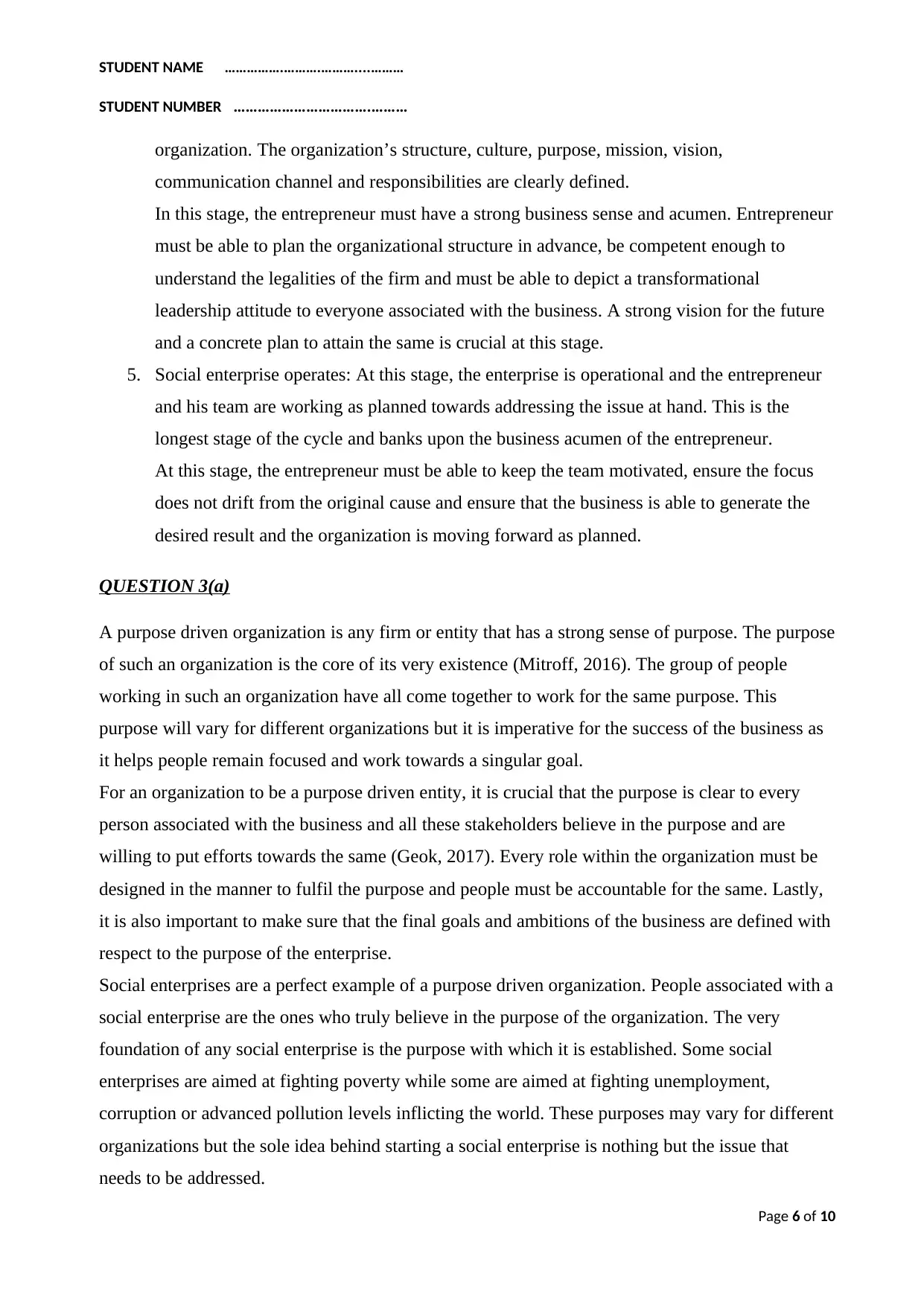
STUDENT NAME …………….……….………....………
STUDENT NUMBER …………………………….………
organization. The organization’s structure, culture, purpose, mission, vision,
communication channel and responsibilities are clearly defined.
In this stage, the entrepreneur must have a strong business sense and acumen. Entrepreneur
must be able to plan the organizational structure in advance, be competent enough to
understand the legalities of the firm and must be able to depict a transformational
leadership attitude to everyone associated with the business. A strong vision for the future
and a concrete plan to attain the same is crucial at this stage.
5. Social enterprise operates: At this stage, the enterprise is operational and the entrepreneur
and his team are working as planned towards addressing the issue at hand. This is the
longest stage of the cycle and banks upon the business acumen of the entrepreneur.
At this stage, the entrepreneur must be able to keep the team motivated, ensure the focus
does not drift from the original cause and ensure that the business is able to generate the
desired result and the organization is moving forward as planned.
QUESTION 3(a)
A purpose driven organization is any firm or entity that has a strong sense of purpose. The purpose
of such an organization is the core of its very existence (Mitroff, 2016). The group of people
working in such an organization have all come together to work for the same purpose. This
purpose will vary for different organizations but it is imperative for the success of the business as
it helps people remain focused and work towards a singular goal.
For an organization to be a purpose driven entity, it is crucial that the purpose is clear to every
person associated with the business and all these stakeholders believe in the purpose and are
willing to put efforts towards the same (Geok, 2017). Every role within the organization must be
designed in the manner to fulfil the purpose and people must be accountable for the same. Lastly,
it is also important to make sure that the final goals and ambitions of the business are defined with
respect to the purpose of the enterprise.
Social enterprises are a perfect example of a purpose driven organization. People associated with a
social enterprise are the ones who truly believe in the purpose of the organization. The very
foundation of any social enterprise is the purpose with which it is established. Some social
enterprises are aimed at fighting poverty while some are aimed at fighting unemployment,
corruption or advanced pollution levels inflicting the world. These purposes may vary for different
organizations but the sole idea behind starting a social enterprise is nothing but the issue that
needs to be addressed.
Page 6 of 10
STUDENT NUMBER …………………………….………
organization. The organization’s structure, culture, purpose, mission, vision,
communication channel and responsibilities are clearly defined.
In this stage, the entrepreneur must have a strong business sense and acumen. Entrepreneur
must be able to plan the organizational structure in advance, be competent enough to
understand the legalities of the firm and must be able to depict a transformational
leadership attitude to everyone associated with the business. A strong vision for the future
and a concrete plan to attain the same is crucial at this stage.
5. Social enterprise operates: At this stage, the enterprise is operational and the entrepreneur
and his team are working as planned towards addressing the issue at hand. This is the
longest stage of the cycle and banks upon the business acumen of the entrepreneur.
At this stage, the entrepreneur must be able to keep the team motivated, ensure the focus
does not drift from the original cause and ensure that the business is able to generate the
desired result and the organization is moving forward as planned.
QUESTION 3(a)
A purpose driven organization is any firm or entity that has a strong sense of purpose. The purpose
of such an organization is the core of its very existence (Mitroff, 2016). The group of people
working in such an organization have all come together to work for the same purpose. This
purpose will vary for different organizations but it is imperative for the success of the business as
it helps people remain focused and work towards a singular goal.
For an organization to be a purpose driven entity, it is crucial that the purpose is clear to every
person associated with the business and all these stakeholders believe in the purpose and are
willing to put efforts towards the same (Geok, 2017). Every role within the organization must be
designed in the manner to fulfil the purpose and people must be accountable for the same. Lastly,
it is also important to make sure that the final goals and ambitions of the business are defined with
respect to the purpose of the enterprise.
Social enterprises are a perfect example of a purpose driven organization. People associated with a
social enterprise are the ones who truly believe in the purpose of the organization. The very
foundation of any social enterprise is the purpose with which it is established. Some social
enterprises are aimed at fighting poverty while some are aimed at fighting unemployment,
corruption or advanced pollution levels inflicting the world. These purposes may vary for different
organizations but the sole idea behind starting a social enterprise is nothing but the issue that
needs to be addressed.
Page 6 of 10
⊘ This is a preview!⊘
Do you want full access?
Subscribe today to unlock all pages.

Trusted by 1+ million students worldwide
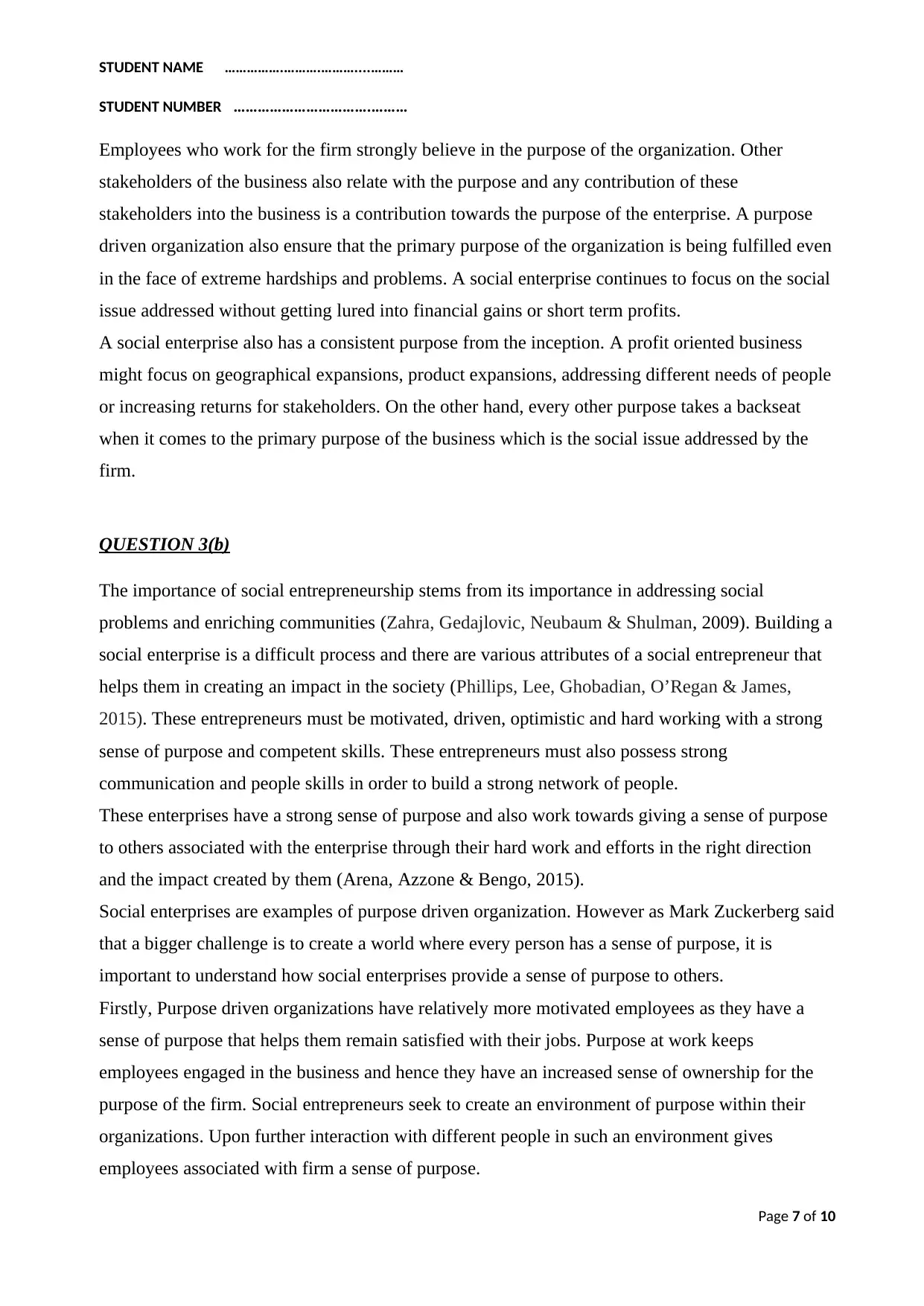
STUDENT NAME …………….……….………....………
STUDENT NUMBER …………………………….………
Employees who work for the firm strongly believe in the purpose of the organization. Other
stakeholders of the business also relate with the purpose and any contribution of these
stakeholders into the business is a contribution towards the purpose of the enterprise. A purpose
driven organization also ensure that the primary purpose of the organization is being fulfilled even
in the face of extreme hardships and problems. A social enterprise continues to focus on the social
issue addressed without getting lured into financial gains or short term profits.
A social enterprise also has a consistent purpose from the inception. A profit oriented business
might focus on geographical expansions, product expansions, addressing different needs of people
or increasing returns for stakeholders. On the other hand, every other purpose takes a backseat
when it comes to the primary purpose of the business which is the social issue addressed by the
firm.
QUESTION 3(b)
The importance of social entrepreneurship stems from its importance in addressing social
problems and enriching communities (Zahra, Gedajlovic, Neubaum & Shulman, 2009). Building a
social enterprise is a difficult process and there are various attributes of a social entrepreneur that
helps them in creating an impact in the society (Phillips, Lee, Ghobadian, O’Regan & James,
2015). These entrepreneurs must be motivated, driven, optimistic and hard working with a strong
sense of purpose and competent skills. These entrepreneurs must also possess strong
communication and people skills in order to build a strong network of people.
These enterprises have a strong sense of purpose and also work towards giving a sense of purpose
to others associated with the enterprise through their hard work and efforts in the right direction
and the impact created by them (Arena, Azzone & Bengo, 2015).
Social enterprises are examples of purpose driven organization. However as Mark Zuckerberg said
that a bigger challenge is to create a world where every person has a sense of purpose, it is
important to understand how social enterprises provide a sense of purpose to others.
Firstly, Purpose driven organizations have relatively more motivated employees as they have a
sense of purpose that helps them remain satisfied with their jobs. Purpose at work keeps
employees engaged in the business and hence they have an increased sense of ownership for the
purpose of the firm. Social entrepreneurs seek to create an environment of purpose within their
organizations. Upon further interaction with different people in such an environment gives
employees associated with firm a sense of purpose.
Page 7 of 10
STUDENT NUMBER …………………………….………
Employees who work for the firm strongly believe in the purpose of the organization. Other
stakeholders of the business also relate with the purpose and any contribution of these
stakeholders into the business is a contribution towards the purpose of the enterprise. A purpose
driven organization also ensure that the primary purpose of the organization is being fulfilled even
in the face of extreme hardships and problems. A social enterprise continues to focus on the social
issue addressed without getting lured into financial gains or short term profits.
A social enterprise also has a consistent purpose from the inception. A profit oriented business
might focus on geographical expansions, product expansions, addressing different needs of people
or increasing returns for stakeholders. On the other hand, every other purpose takes a backseat
when it comes to the primary purpose of the business which is the social issue addressed by the
firm.
QUESTION 3(b)
The importance of social entrepreneurship stems from its importance in addressing social
problems and enriching communities (Zahra, Gedajlovic, Neubaum & Shulman, 2009). Building a
social enterprise is a difficult process and there are various attributes of a social entrepreneur that
helps them in creating an impact in the society (Phillips, Lee, Ghobadian, O’Regan & James,
2015). These entrepreneurs must be motivated, driven, optimistic and hard working with a strong
sense of purpose and competent skills. These entrepreneurs must also possess strong
communication and people skills in order to build a strong network of people.
These enterprises have a strong sense of purpose and also work towards giving a sense of purpose
to others associated with the enterprise through their hard work and efforts in the right direction
and the impact created by them (Arena, Azzone & Bengo, 2015).
Social enterprises are examples of purpose driven organization. However as Mark Zuckerberg said
that a bigger challenge is to create a world where every person has a sense of purpose, it is
important to understand how social enterprises provide a sense of purpose to others.
Firstly, Purpose driven organizations have relatively more motivated employees as they have a
sense of purpose that helps them remain satisfied with their jobs. Purpose at work keeps
employees engaged in the business and hence they have an increased sense of ownership for the
purpose of the firm. Social entrepreneurs seek to create an environment of purpose within their
organizations. Upon further interaction with different people in such an environment gives
employees associated with firm a sense of purpose.
Page 7 of 10
Paraphrase This Document
Need a fresh take? Get an instant paraphrase of this document with our AI Paraphraser
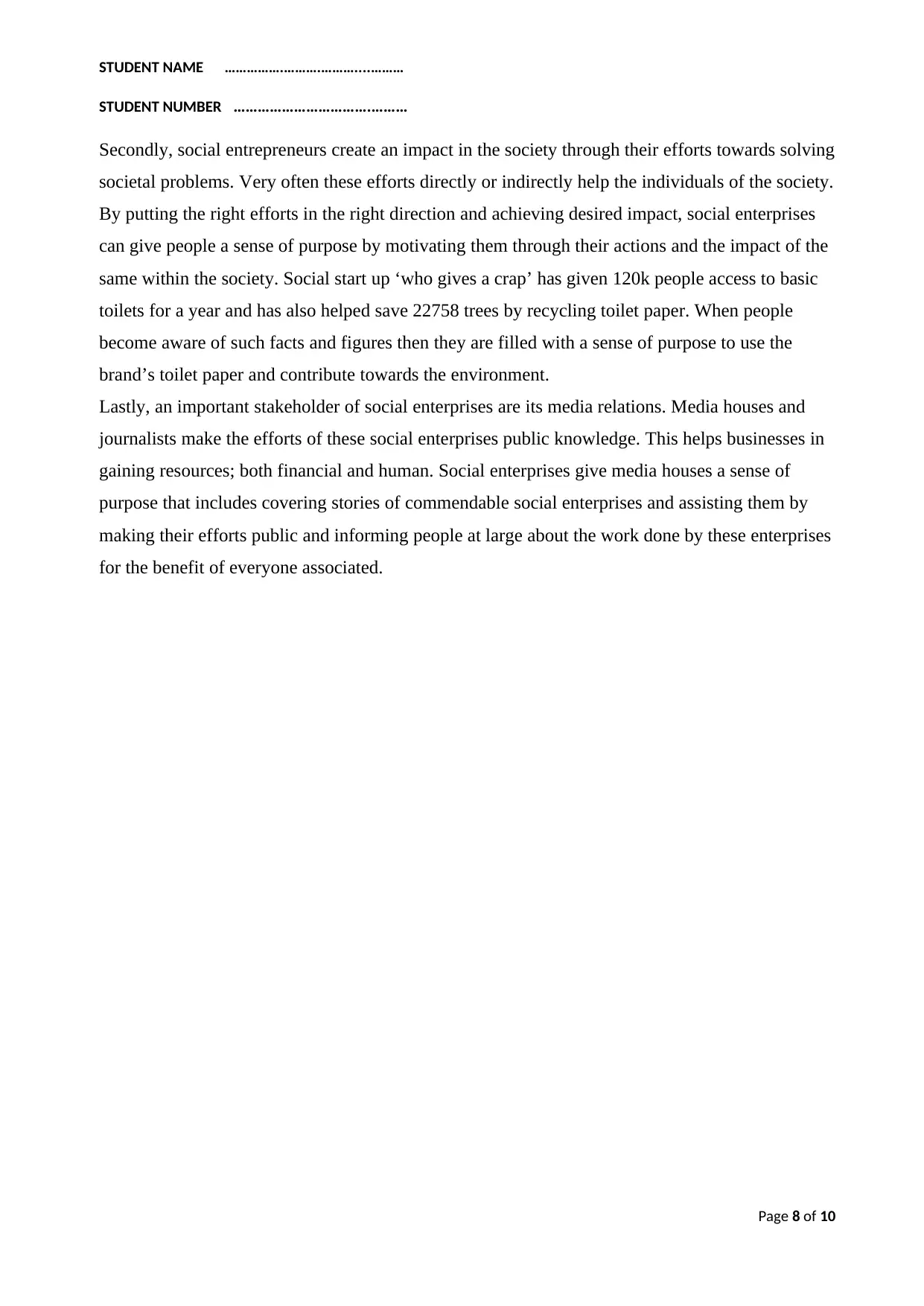
STUDENT NAME …………….……….………....………
STUDENT NUMBER …………………………….………
Secondly, social entrepreneurs create an impact in the society through their efforts towards solving
societal problems. Very often these efforts directly or indirectly help the individuals of the society.
By putting the right efforts in the right direction and achieving desired impact, social enterprises
can give people a sense of purpose by motivating them through their actions and the impact of the
same within the society. Social start up ‘who gives a crap’ has given 120k people access to basic
toilets for a year and has also helped save 22758 trees by recycling toilet paper. When people
become aware of such facts and figures then they are filled with a sense of purpose to use the
brand’s toilet paper and contribute towards the environment.
Lastly, an important stakeholder of social enterprises are its media relations. Media houses and
journalists make the efforts of these social enterprises public knowledge. This helps businesses in
gaining resources; both financial and human. Social enterprises give media houses a sense of
purpose that includes covering stories of commendable social enterprises and assisting them by
making their efforts public and informing people at large about the work done by these enterprises
for the benefit of everyone associated.
Page 8 of 10
STUDENT NUMBER …………………………….………
Secondly, social entrepreneurs create an impact in the society through their efforts towards solving
societal problems. Very often these efforts directly or indirectly help the individuals of the society.
By putting the right efforts in the right direction and achieving desired impact, social enterprises
can give people a sense of purpose by motivating them through their actions and the impact of the
same within the society. Social start up ‘who gives a crap’ has given 120k people access to basic
toilets for a year and has also helped save 22758 trees by recycling toilet paper. When people
become aware of such facts and figures then they are filled with a sense of purpose to use the
brand’s toilet paper and contribute towards the environment.
Lastly, an important stakeholder of social enterprises are its media relations. Media houses and
journalists make the efforts of these social enterprises public knowledge. This helps businesses in
gaining resources; both financial and human. Social enterprises give media houses a sense of
purpose that includes covering stories of commendable social enterprises and assisting them by
making their efforts public and informing people at large about the work done by these enterprises
for the benefit of everyone associated.
Page 8 of 10
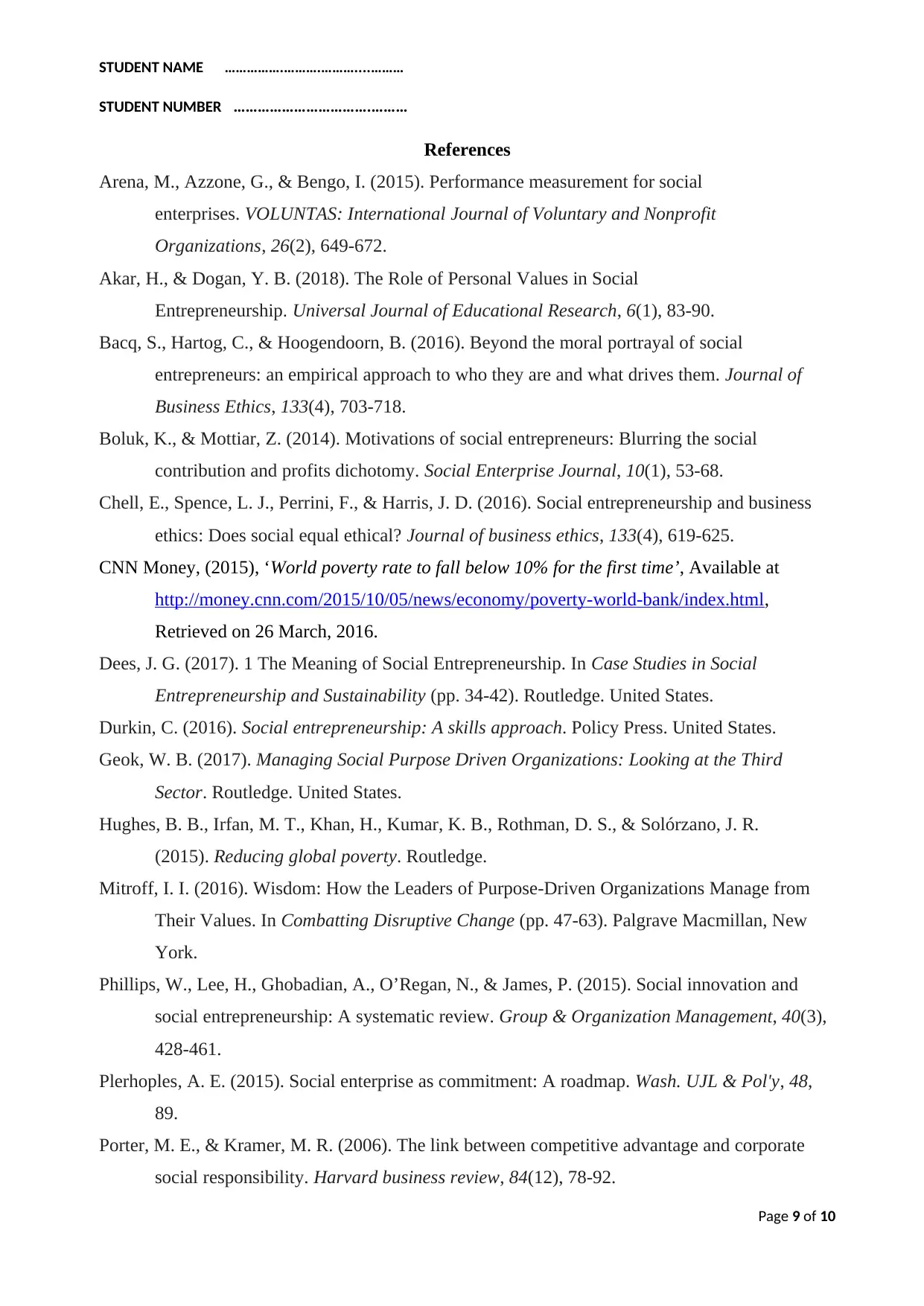
STUDENT NAME …………….……….………....………
STUDENT NUMBER …………………………….………
References
Arena, M., Azzone, G., & Bengo, I. (2015). Performance measurement for social
enterprises. VOLUNTAS: International Journal of Voluntary and Nonprofit
Organizations, 26(2), 649-672.
Akar, H., & Dogan, Y. B. (2018). The Role of Personal Values in Social
Entrepreneurship. Universal Journal of Educational Research, 6(1), 83-90.
Bacq, S., Hartog, C., & Hoogendoorn, B. (2016). Beyond the moral portrayal of social
entrepreneurs: an empirical approach to who they are and what drives them. Journal of
Business Ethics, 133(4), 703-718.
Boluk, K., & Mottiar, Z. (2014). Motivations of social entrepreneurs: Blurring the social
contribution and profits dichotomy. Social Enterprise Journal, 10(1), 53-68.
Chell, E., Spence, L. J., Perrini, F., & Harris, J. D. (2016). Social entrepreneurship and business
ethics: Does social equal ethical? Journal of business ethics, 133(4), 619-625.
CNN Money, (2015), ‘World poverty rate to fall below 10% for the first time’, Available at
http://money.cnn.com/2015/10/05/news/economy/poverty-world-bank/index.html,
Retrieved on 26 March, 2016.
Dees, J. G. (2017). 1 The Meaning of Social Entrepreneurship. In Case Studies in Social
Entrepreneurship and Sustainability (pp. 34-42). Routledge. United States.
Durkin, C. (2016). Social entrepreneurship: A skills approach. Policy Press. United States.
Geok, W. B. (2017). Managing Social Purpose Driven Organizations: Looking at the Third
Sector. Routledge. United States.
Hughes, B. B., Irfan, M. T., Khan, H., Kumar, K. B., Rothman, D. S., & Solórzano, J. R.
(2015). Reducing global poverty. Routledge.
Mitroff, I. I. (2016). Wisdom: How the Leaders of Purpose-Driven Organizations Manage from
Their Values. In Combatting Disruptive Change (pp. 47-63). Palgrave Macmillan, New
York.
Phillips, W., Lee, H., Ghobadian, A., O’Regan, N., & James, P. (2015). Social innovation and
social entrepreneurship: A systematic review. Group & Organization Management, 40(3),
428-461.
Plerhoples, A. E. (2015). Social enterprise as commitment: A roadmap. Wash. UJL & Pol'y, 48,
89.
Porter, M. E., & Kramer, M. R. (2006). The link between competitive advantage and corporate
social responsibility. Harvard business review, 84(12), 78-92.
Page 9 of 10
STUDENT NUMBER …………………………….………
References
Arena, M., Azzone, G., & Bengo, I. (2015). Performance measurement for social
enterprises. VOLUNTAS: International Journal of Voluntary and Nonprofit
Organizations, 26(2), 649-672.
Akar, H., & Dogan, Y. B. (2018). The Role of Personal Values in Social
Entrepreneurship. Universal Journal of Educational Research, 6(1), 83-90.
Bacq, S., Hartog, C., & Hoogendoorn, B. (2016). Beyond the moral portrayal of social
entrepreneurs: an empirical approach to who they are and what drives them. Journal of
Business Ethics, 133(4), 703-718.
Boluk, K., & Mottiar, Z. (2014). Motivations of social entrepreneurs: Blurring the social
contribution and profits dichotomy. Social Enterprise Journal, 10(1), 53-68.
Chell, E., Spence, L. J., Perrini, F., & Harris, J. D. (2016). Social entrepreneurship and business
ethics: Does social equal ethical? Journal of business ethics, 133(4), 619-625.
CNN Money, (2015), ‘World poverty rate to fall below 10% for the first time’, Available at
http://money.cnn.com/2015/10/05/news/economy/poverty-world-bank/index.html,
Retrieved on 26 March, 2016.
Dees, J. G. (2017). 1 The Meaning of Social Entrepreneurship. In Case Studies in Social
Entrepreneurship and Sustainability (pp. 34-42). Routledge. United States.
Durkin, C. (2016). Social entrepreneurship: A skills approach. Policy Press. United States.
Geok, W. B. (2017). Managing Social Purpose Driven Organizations: Looking at the Third
Sector. Routledge. United States.
Hughes, B. B., Irfan, M. T., Khan, H., Kumar, K. B., Rothman, D. S., & Solórzano, J. R.
(2015). Reducing global poverty. Routledge.
Mitroff, I. I. (2016). Wisdom: How the Leaders of Purpose-Driven Organizations Manage from
Their Values. In Combatting Disruptive Change (pp. 47-63). Palgrave Macmillan, New
York.
Phillips, W., Lee, H., Ghobadian, A., O’Regan, N., & James, P. (2015). Social innovation and
social entrepreneurship: A systematic review. Group & Organization Management, 40(3),
428-461.
Plerhoples, A. E. (2015). Social enterprise as commitment: A roadmap. Wash. UJL & Pol'y, 48,
89.
Porter, M. E., & Kramer, M. R. (2006). The link between competitive advantage and corporate
social responsibility. Harvard business review, 84(12), 78-92.
Page 9 of 10
⊘ This is a preview!⊘
Do you want full access?
Subscribe today to unlock all pages.

Trusted by 1+ million students worldwide

STUDENT NAME …………….……….………....………
STUDENT NUMBER …………………………….………
Smith, R., Bell, R., & Watts, H. (2014). Personality trait differences between traditional and social
entrepreneurs. Social Enterprise Journal, 10(3), 200-221.
Townsend, P. (2014). International analysis poverty. Routledge. United States.
Tuten, T. L., & Solomon, M. R. (2017). Social media marketing. Sage. United Kingdom.
Zaefarian, R., Tasavori, M., & Ghauri, P. N. (2015). A corporate social entrepreneurship approach
to market-based poverty reduction. Emerging Markets Finance and Trade, 51(2), 320-334.
Zahra, S. A., Gedajlovic, E., Neubaum, D. O., & Shulman, J. M. (2009). A typology of social
entrepreneurs: Motives, search processes and ethical challenges. Journal of business
venturing, 24(5), 519-532.
Page 10 of 10
STUDENT NUMBER …………………………….………
Smith, R., Bell, R., & Watts, H. (2014). Personality trait differences between traditional and social
entrepreneurs. Social Enterprise Journal, 10(3), 200-221.
Townsend, P. (2014). International analysis poverty. Routledge. United States.
Tuten, T. L., & Solomon, M. R. (2017). Social media marketing. Sage. United Kingdom.
Zaefarian, R., Tasavori, M., & Ghauri, P. N. (2015). A corporate social entrepreneurship approach
to market-based poverty reduction. Emerging Markets Finance and Trade, 51(2), 320-334.
Zahra, S. A., Gedajlovic, E., Neubaum, D. O., & Shulman, J. M. (2009). A typology of social
entrepreneurs: Motives, search processes and ethical challenges. Journal of business
venturing, 24(5), 519-532.
Page 10 of 10
1 out of 10
Related Documents
Your All-in-One AI-Powered Toolkit for Academic Success.
+13062052269
info@desklib.com
Available 24*7 on WhatsApp / Email
![[object Object]](/_next/static/media/star-bottom.7253800d.svg)
Unlock your academic potential
Copyright © 2020–2025 A2Z Services. All Rights Reserved. Developed and managed by ZUCOL.





